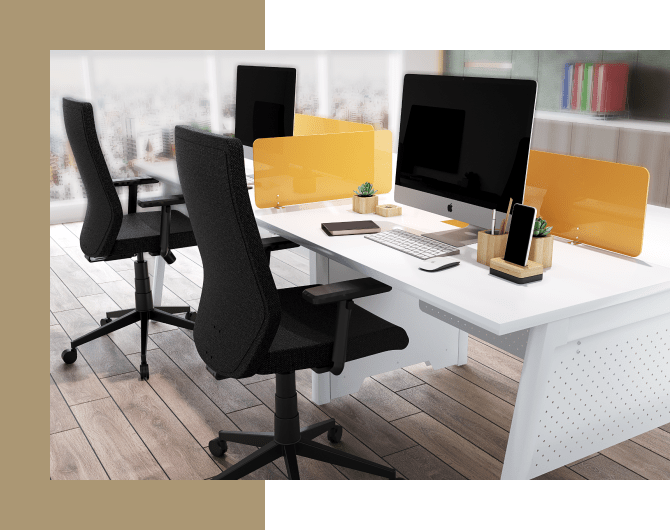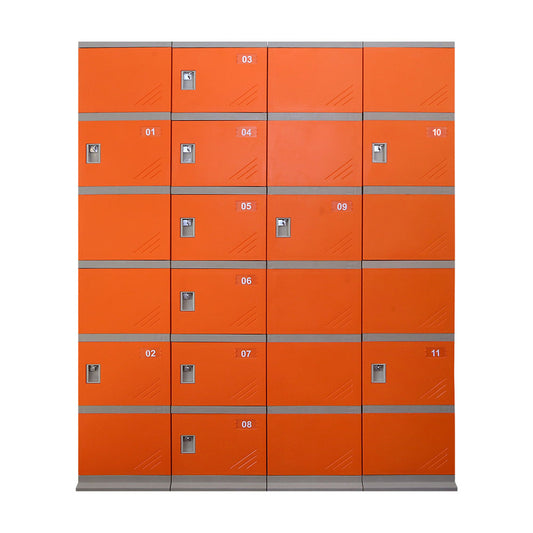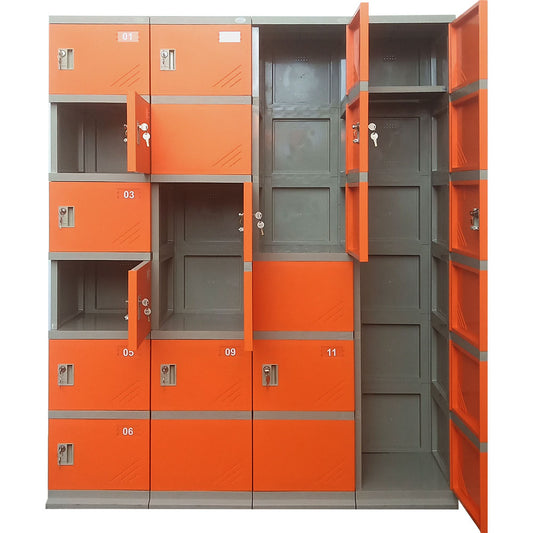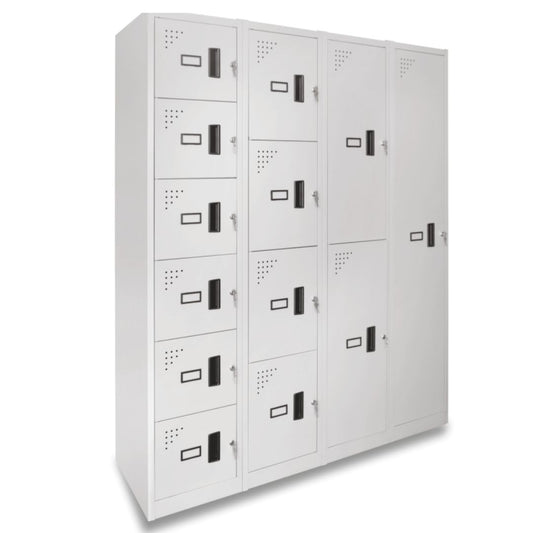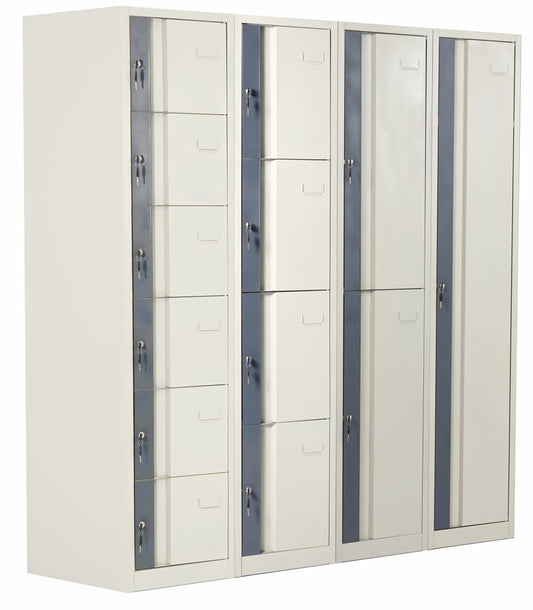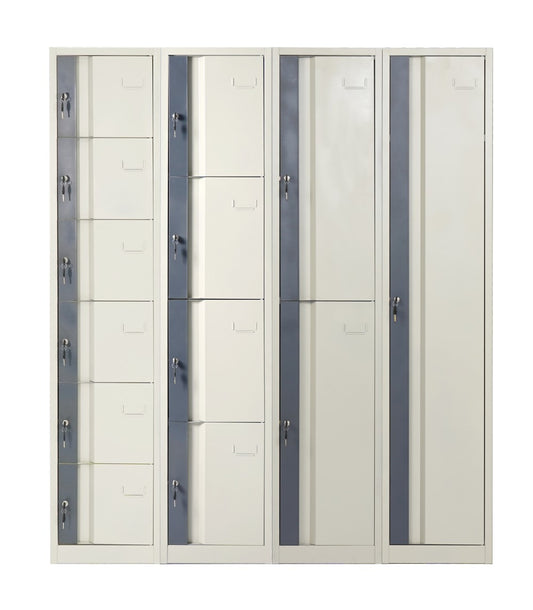Collection: Locker Room
Enquiry Form
Collection: Locker Room
Personal locker units play an essential role in healthcare environments. They are designed to provide convenient access to secure storage for employees' personal possessions.
These lockers aid in maintaining a clean and hygienic environment, which is crucial in healthcare facilities. Nilkamal Edge offers a range of durable and useful options, including bedside lockers, smart lockers, etc. We design and manufacture fully integrated storage systems with a focus on security and simplicity to meet the diverse needs of healthcare environments. Nilkamal Edge supplies a range of solutions, and one of the most popular is the Squadro Personal Locker, which offers a strong and adaptable storage solution.
Our extensive collection of healthcare staff lockers is made of premium materials, like virgin polypropylene, which guarantees sturdiness and ease of maintenance. The locker room furniture is fully modular, which facilitates customisation to meet specific requirements. Our Healthcare locker room furniture also promotes industry-level security like sturdily constructed locking mechanisms.
Since our bedside lockers come in a variety of finishes, you may design a room that is not only practical but also aesthetically pleasing. Our hospital locker unit storage will, therefore, ideally complement your vision for the space, whether you're trying to update your staff area or you just want your lockers to match your design scheme.
We have everything you require to keep full oversight, boost productivity, and arrange your workspace. We provide individuals with the tools and space they need to perform their work in a way that increases their efficiency, productivity, and safety.
Things to Take Care of Before Enquiring About Healthcare Locker Room Furniture
When investing in healthcare office lockers, it's important to pay attention to a number of variables to make sure that the investment fits the facility's unique requirements and improves staff comfort, safety, and functionality. The following are the important considerations:
Material and Durability: Antimicrobial materials are the best choice for locker construction since they effectively prevent the propagation of infections in medical facilities. The furniture should also be durable enough to resist regular cleanings and extensive use. Metal and premium plastic lockers are highly preferred in healthcare facilities because of their resilience and toughness features.
Security Features: Safety specifications are another crucial pointer you need to take into account while choosing locker room furniture. Officer lockers employed in healthcare facilities must have sturdy locks. There are a variety of security lock options available, and electronic locks and combination locks are the most popular among them. For efficient personal possessions security, make sure each locker should have its own lock.
Ergonomics and Design: Select layouts that make the best use of available space. In small spaces, stackable or modular lockers may be a viable way to accommodate more units. To avoid injuries, make sure the small lockers have smooth edges and ergonomic handles. Furthermore, take into account everyone on staff's height and accessibility, including those with disabilities.
Ventilation: Staff lockers with ventilation systems keep goods fresh and help avoid smells. Keeping the locker room hygienic requires proper ventilation; therefore, consider keeping this factor in mind when purchasing healthcare locker room furniture.
Comfort and aesthetics: The locker unit storage furniture should complement the facility's overall design. A unified appearance might help to create a more pleasant and professional atmosphere. Furthermore, staff should be provided with comfortable seating spots or seats in the locker room so they may change comfortably.
Read More: Optimising Healthcare: Storage Amenities for Improved Staff Morale
Advantages of Health Care Locker Room Furniture
As many hospitals use flexible furniture and fixtures to make better use of their limited space, locker unit storage is still a requirement. Healthcare employee lockers provide several benefits that improve the overall efficiency and organisation. A few key advantages of healthcare locker room furniture include:
Security: There are various advantages to having personal lockers in healthcare facilities. First and foremost, one of the most crucial considerations for healthcare staff members is security. The comfort and certainty that their belongings would be safe from potential theft and damage are essential for hospital staff. Many of them include advanced locking mechanisms.
Improved Organisation. In high-traffic places like hospitals and clinics, having separate spaces for personal goods, like locker rooms, helps maintain an ordered and clutter-free atmosphere.
Enhanced Workplace Mood and Efficiency. Giving employees private, secure storage places lowers stress and increases their sense of worth, which boosts morale and improves job satisfaction. Contemporary furniture for staff lockers incorporates electronic device charging outlets, enabling medical personnel to maintain their gadgets charged and prepared for use throughout their shifts.
Compliance with health and safety regulations. One of the most important benefits of implementing high-quality metal lockers is that it is mandated by law. Employers must provide safe, suitable clothes storage as well as adequate changing rooms for staff members who need to change into work attire in order to perform their duties. This is defined in the Workplace (Health, Safety, and Welfare) Act 1992.
Key Features of the Health Care Locker Room Furniture
Healthcare locker rooms are built with specific characteristics to fulfil the needs of different medical settings. Specially designed locker room furniture allows both functionality and comfort for healthcare workers. The following are salient characteristics of healthcare locker rooms of superior quality:
Sturdy and Sanitised Materials: High-quality plastic, treated wood, etc., are common materials used to make healthcare furniture, including locker rooms. These materials are durable, making them ideal for high-traffic environments like hospitals. The surfaces of bedside and staff lockers are designed to be simple to clean and disinfect. These surfaces reduce the transmission of infection and improve cleanliness in hospitals.
Ventilation: Certain smart lockers include built-in ventilation systems for hygiene reasons. These vents let fresh air flow into the locker, which dries out items like perspiring clothing and keeps bad odours from accumulating. Lacking this ventilation system, a substantial volume of moisture would remain in the interior atmosphere. That implies that odours, mould and mildew can quickly accumulate and pose a hygiene issue in healthcare facilities.
Security Features: The majority of small lockers are equipped with safe locking systems, such as combination locks, electronic locks, etc., to safeguard against the loss of personal items. The lockers' strong construction guarantees their durability and tamper-proof nature, providing an additional degree of security for staff members' valuables.
Ergonomic and user-friendly design. Ergonomic designs like handles, edges, etc., in these staff lockers, improve staff comfort and lower the risk of injury. Numerous lockers feature quiet closure mechanisms, which reduce noise and help create a peaceful atmosphere in the hospitals.
5. Flexibility and Customisation: A common element of furniture is its modular design, which enables customisation to match the unique requirements of the facility. This may involve movable shelves, various compartment sizes, etc. Modern employee lockers may have extra spaces for shoes and uniforms, increasing efficiency.
Read More: Choose The Right Hospital Furniture With This Handy Guide
Select From a Wide Range of Health Care Locker Room Furniture Collections From Nilkamal
Nilkamal Edge is a trusted supplier of bespoke room and bedside lockers, as well as other healthcare furniture solutions. We offer a diverse range of healthcare locker room furniture designed to meet the specific needs of medical facilities. These products combine durability, security, and hygiene with user-friendly design and customisation options. Here’s an overview of some of the options available, highlighting their features and benefits:
1. Squadro Personal Locker Unit Storage
● Material: Made from high-quality virgin polypropylene, ensuring durability and ease of maintenance.
● Design: Modular design allows customisation and easy assembly. The lockers are lightweight yet robust, making them suitable for heavy usage.
● Security: Equipped with secure locking mechanisms to protect personal belongings.
● Hygiene: Easy to clean and resistant to corrosion and chemical damage, ideal for maintaining hygiene in healthcare settings
2. Lockrbox Personal Locker Unit Storage
● Construction: Made from 100% virgin polypropylene, offering excellent durability and resistance to rust and corrosion. Polypropylene is a lightweight material, making the lockers easy to move and install.
● Knockdown Structure: The Lockerbox office lockers are designed with a knockdown structure. This structure makes assembling and disassembling convenient.
● Features: This locker system comes with three lock features.
○ Pad Lock: This is a traditional lock that offers simplicity and the flexibility to change the padlock if needed.
○ Cam Lock: A cam lock is a mechanical lock that is commonly used in smart lockers. It provides good security and is easy to operate.
○ Num Lock: A numeric lock, or combination lock, adds an extra layer of security by allowing users to set a personal combination code. This type of lock is convenient as it eliminates the need for keys.
Explore Various Types of Health Care Locker Room Furniture
Healthcare smart lockers are adaptable and help provide staff with effective storage options. Here's a glimpse at different types of healthcare locker room furniture, showcasing their features and benefits:
1. Personal Lockers: These are the most popular type of hospital locker room furniture. They are frequently built using sturdy materials that guarantee their rust resistance and ease of cleaning. Strong locking systems, including combination locks, cam locks, etc., are installed in the majority of them to ensure the security of personal property. Frequently, they have movable shelves and sections to facilitate enhanced organising.
2. Modular Locker Systems: Modular smart lockers are adaptable and can be set up to accommodate different requirements. The modular locker system facilitates speedy installation and relocation within the building. Furthermore, they are easy to assemble and disassemble. They offer a range of storage options with double-, triple-and six-locker units among their available combinations.
3. Ventilated Lockers: The ventilated features of these medical personal locker rooms promote air circulation. They work well to prevent the smells and the growth of mould and mildew. This is especially crucial for preserving a clean atmosphere in medical facilities.
4. Integrated Charging Lockers: The built-in charging connections in these lockers offer a high degree of convenience, enabling employees to store and recharge their personal devices while working safely. Advanced locking mechanisms integration in this locking room furniture provides a high level of protection for both gadgets and personal possessions.
5. Bench Lockers: These lockers have two distinct uses. These lockers provide staff members with a comfortable location to change clothes and keep personal belongings because they combine seats and storage. The integrated bench helps to optimise space, particularly in small locker rooms.
6. Mobile Storage Units: Mobile storage units are outfitted with wheels. This healthcare locker room furniture allows for easy transportation and reconfiguration within the locker room or elsewhere in the medical care facility. These kinds of containers offer a flexible storage option and can be used to store a variety of items, such as personal possessions or medical supplies.
Speciation of Health Care Locker Room
Healthcare locker room furniture is an integral component in medical facilities that promotes organised, hygienic, and secure environments for medical staff. Here are the key specifications:
- Material: Often made from high-quality materials like stainless steel, powder-coated steel, or virgin polypropylene, ensuring durability and resistance to rust and corrosion.
- Design: Modular and customisable configurations, including single, double, triple, and six-locker units, allow for tailored solutions to fit specific space requirements. Knockdown structures facilitate easy assembly and reconfiguration.
- Hygiene: Features such as ventilated doors help prevent odour and mould, which is crucial in maintaining a clean environment. Surfaces are designed for easy cleaning and disinfection.
- Security: Equipped with various locking mechanisms, including padlocks, cam locks, and combination locks, to ensure the safety of personal belongings.
Additional Features: Options may include integrated charging ports, benches, and ergonomic handles to enhance convenience and comfort.
FAQ's
Yes, there is a great deal of customisation available for healthcare locker room solutions to meet various space needs. A lot of healthcare small lockers are made with modularity in mind, like the ones that Nilkamal Edge offers. This lets medical facilities combine various units to make a configuration that suits their unique space requirements. These lockers' knockdown design makes it simple to assemble and rearrange, allowing facilities to modify the locker arrangement as needs change over time. There are many locker sizes, ranging from one to six locker units. This variety of sizes maximises space utilisation, regardless of dimensions.
Healthcare locker room solutions are available in an array of sizes to meet varying needs in terms of storage and space. Below, we present a common selection of available sizes:
- Standard Locker Sizes Single-Tier Lockers: These are full-height lockers with dimensions typically 72 inches (6 feet) high, 12 to 15 inches broad, and 18 to 24 inches deep. They provide lots of room for storing personal belongings and hanging other stuff.
- Double-Tier Lockers: These lockers are separated into two portions, each typically 36 inches tall, offering a similar total height as single-tier lockers while allowing for more users in the same vertical space. They maintain the same width and depth as single-tier lockers.
- Triple-Tier Lockers: There are three portions inside these healthcare room lockers, each measuring approximately 24 inches in height. This arrangement works well for packing up smaller objects and fitting as many lockers as possible into a limited area.
- Six-Tier Lockers: These are split into six sections, each measuring between 12 and 15 inches in height. They are perfect for extremely small storage solutions. Many locker systems are modular and adaptable, allowing for arrangements with one, two, or more columns, as well as different heights and widths to meet specific requirements. These can be customised to fulfil specific storage needs and optimize space efficiency in different medical facilities.
Yes, healthcare locker room solutions include options for both wall-mounted and freestanding units. Wall-mounted lockers are perfect for institutions with limited floor space. Since they are mounted on the wall, the floor space can be used for other things, such as chairs or other equipment. Being lifted off the ground makes cleaning the room easier, which is critical for preserving hygiene in healthcare environments. These lockers come in a range of sizes and layouts to accommodate different types of storage requirements. They frequently have features like ventilation slots, and they can have one or more compartments. Freestanding lockers can be installed anywhere in the locker room, providing greater flexibility in layout and reconfiguration. This is particularly helpful in dynamic settings where storage requirements could fluctuate over time. They frequently have strong bases that are easily movable without requiring permanent installation.
Yes, Many locker room structures are modular, allowing for easy extension or reconfiguration. These modular systems are made to be versatile and accommodating to various settings and requirements. They frequently consist of individual locker sections that may be combined and reconfigured in various configurations to meet changing needs or spatial restrictions. Because of this adaptability, expanding the locker room or changing its layout as needed is simpler and doesn't require extensive repairs or cause substantial disruptions to the area.
Although standard lockers can be found in a variety of sizes and designs, single-compartment lockers are a popular choice. However, lockers can have several compartments, such as two- or three-tier lockers. Single-compartment lockers come in a variety of sizes, but the average dimensions are approximately 12 inches (30 cm) wide, 12 inches (30 cm deep), and 72 inches (183 cm) high. In multi-tier lockers, every section is often smaller to fit more individuals in the same vertical area. These sections' sizes may also differ based on the locker system's particular design.
Here are some effective strategies for organising lockers:
- Organise lockers in an orientation that reduces congestion and promotes seamless movement across the locker room. Leave enough space between rows of lockers and make sure pathways are broad enough for medical staff to navigate comfortably. Corner spaces are frequently neglected. However, they might be useful for locker placement. Installing lockers along walls and in corners can help to enhance space efficiency. Select lockers with space-saving designs or layouts to maximise available area. Make sure that there's adequate room surrounding each locker so that users can easily open and close them. Set up lockers at different heights to accommodate individuals with various levels of mobility. Install some lockers at lower heights to accommodate wheelchairs while keeping others at conventional heights for standing users. Q. How secure are lockers, and what features are available to ensure the safety of stored items? A. Depending on the construction and composition, lockers can have varying levels of security. Typical security elements include the following:
- Locking Mechanisms: Various locking mechanisms, including padlocks, combination locks, etc, frequently come with lockers. Each locking type provides differing degrees of safety and convenience.
- Robust Design: Premium lockers are frequently constructed from robust materials which offer resilience against manipulation and damage. Lockers with reinforced doors and hinges are able to resist damage and forced access. For increased strength, several lockers also include welded construction.
- Visibility and Ventilation: Perforations or mesh panels on lockers allow for ventilation while preserving the contents' visibility. This makes it easy to keep an eye on the contents of the lockers, which can help prevent theft. Some lockers come with anti-pry measures, like recessed door handles, to keep out unwanted users.
Here are some common types of locks used in office lockers:
- Padlocks: Padlocks are external locks that connect to a hasp or loop on the locker door. They are adaptable and simple to replace in case they break.
- Key Locks: Unlocking a key lock requires a physical key. Each locker has a unique key, ensuring safe access control.
- Combination Locks: Combination locks use a numeric or alphanumeric code to unlock the locker.
- Electronic Keypad Locks: Electronic keypad locks require users to enter a PIN code or swipe a key card or RFID token to unlock the locker. They offer keyless entry.
- Biometric Locks: Biometric locks use fingerprint and facial recognition technology to grant access to the locker. Biometric locks offer high-security authentication.
- RFID Locks: These locks employ RFID technology to unlock a locker with a suitable RFID card or token. RFID locks can be combined with access control systems to increase security.
Several important factors and considerations should be kept in mind while selecting a combination (num) lock, padlock, or cam lock for staff or bedside locker security:
- Security Level: Security levels for cam locks and padlocks may vary based on the materials and lock quality. Combination locks provide security due to the uniqueness of the combination; however, the security level might be jeopardised if the key combination is leaked.
- Convenience: Padlocks require operators to keep a physical key or know a combination, whereas cam locks can be accessed with a key or a keyless twist knob. Keyless entry is possible with combination locks, but users must remember or write down the combination.
- Durability: Padlocks and cam locks are made from durable materials. Durable substances like hardened steel are more vulnerable to theft and corrosion.
- Accessibility: Cam locks with large twist knobs or combination locks with easy-to-read dials may be more accessible than traditional key locks.
- Cost: Padlocks and cam locks may be more affordable upfront, while combination locks and electronic locks may have higher initial costs but lower long-term maintenance costs.
Generally, cam locks have an easy-to-use, basic mechanism. Lockers are easy to use for everyone to access by simply inserting and turning a key or twisting a knob. The strong locking mechanism of cam locks provides robust security. Cam locks, when set correctly, offer a safe barrier against unwanted entry, discouraging theft and damage. Physical keys can be used to activate cam locks, giving physical access control. Facility managers can give keys to approved personnel while keeping track of who has access to the lockers.
Here are the key features and security benefits of using padlocks for office lockers:
- Portability: Padlocks are compact and easy for users to carry. Padlocks are ideal for use in shared or mobile storage facilities because of their portability.
- Universal Compatibility: These locks are generally compatible with a wide range of locker types.
- Keyless Operation: Padlocks offer keyless operation. Therefore, it eliminates the need for users to carry keys or remember combinations.
- Customisable Combinations: A lot of padlocks let customers customise the combination, offering customised safety. With this tweak, customers can select a combination that effectively protects their belongings while being simple to remember.
- Cost-Effectiveness: Padlocks' primary benefit over other locking methods is their lower cost.
- Quick Installation: You don't need any specialisation or tools to install padlocks. Quick and easy installation makes them the most popular option in small lockers.
Combination locks, also known as num locks, offer several unique features and advantages for locker security:
- Keyless Entry: Combination locks provide keyless entry, eliminating the need for users to carry physical keys.
- Customisable Combinations: Combination locks provide personalised security. It allows users to set their own unique combination.
- No Risk of Lost Keys: Since combination locks do not require keys, there is no risk of users losing their keys and being unable to access their lockers.
- Convenience: Combination locks offer convenience for users who may find it easier to remember a combination than to carry and manage keys.
- Multiple User Access: Combination locks can be easily shared among multiple users, allowing for flexible access control in shared locker facilities.
- Security: Combination smart locks provide reliable security through the uniqueness of the combination. When properly set and maintained, combination locks offer effective protection against unauthorised access to locker contents.

